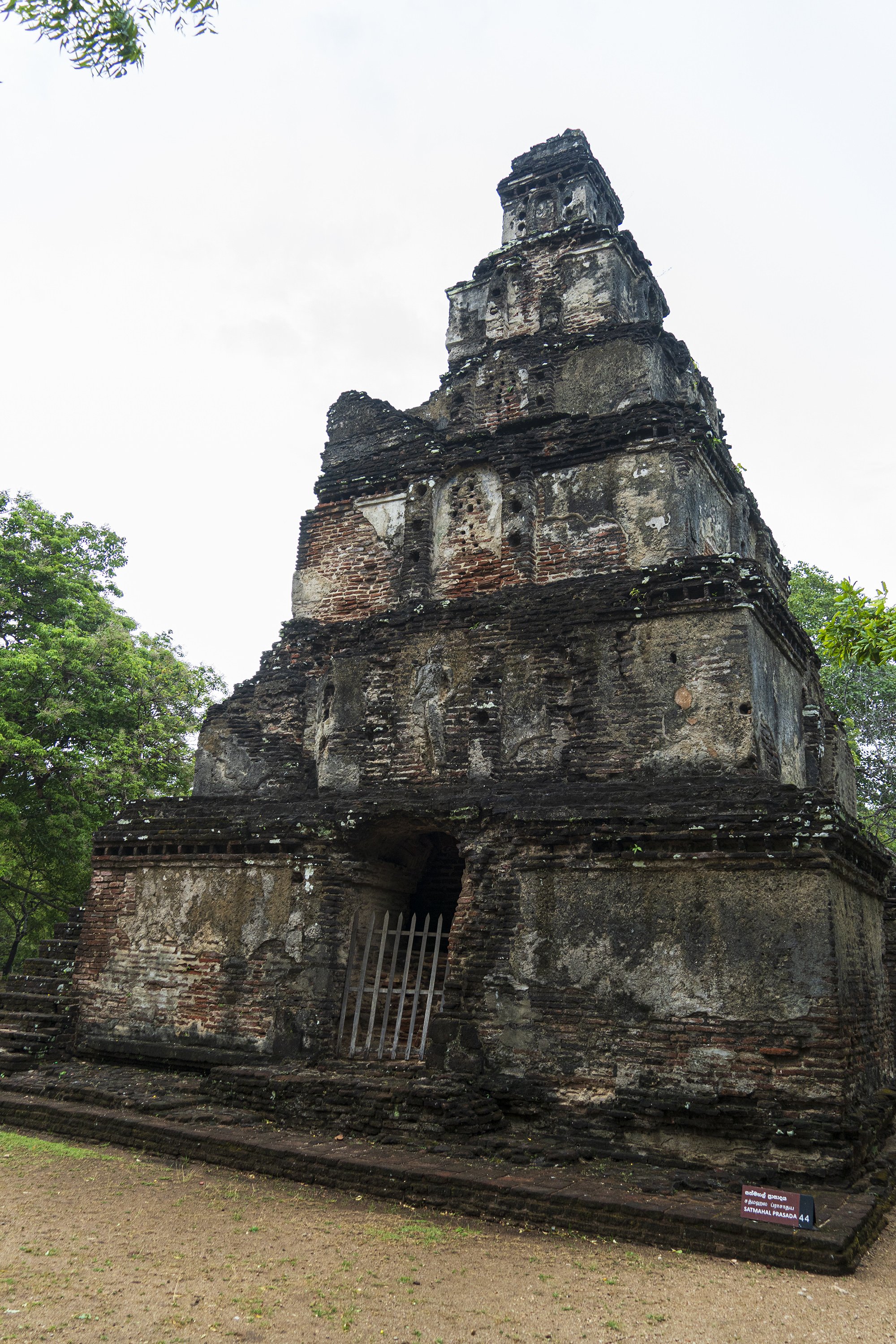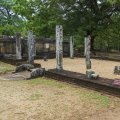Polonnaruwa (ancient city): photo 51
Photo 51 of 64 in Gallery: Polonnaruwa (ancient city)

Image title: Satmahal Prasada
Description of the photo
English text:
Although known as Satmahal Prasada its ancient name or other facts of this edifice are not known. Despite the fact that there is reference in the Mahavamsa that King Parakramabahu the Great (1153-1186AD) built a Satmahal Prasada in Polonnaruva there is no positive evidence that it is this building. Built in the stepped pyramidal form, this seven-storied structure may be a stupa of a rare kind. It bears a close similarity to the stupa at Wat Kukut in Lamphun, Thailand. The architectural features common in south-east Asian countries are also visible in this building.
Sinhalese text (not proofread):
සාම්ප්රදායිකව සත් ත්මහල් ප්රායාදය ලෙස මෙම ගොඩනැගිල්ල හැඳින් වුවත් මෙහි පැරණි නම තේ අනෙකුත් තොරතුරු මෙතෙක් නිශ්චිතව හෙළි දරව් කරගෙන නොමැත. මනෝ පරාක්රමබාහු රජු (6.ව. 1153 - 1186) විසින් පොළොන්නරුවේ සත්මහල් ප්රාසාදයක් ඉදිකල බවට මහාවංශයේ සඳහන්ව ඇතත් ඒ මෙම ගොඩනැගිල්ල බව විශ්වාය කිරීම අපයවේ. ඉහලට නැගෙන විට ක්රමයෙන් කුඩා වන ලෙස ඉදි කළ මහල් හතකින් යුත් මෙම අටල්ල විරල ගණයේ ස්තූපයක් විය හැකිය. තායිලන්තයේ ලමින් වාත් කුකුත් විහාරයේ බිතුපය මීට බෙහෙවින් යාමානය. අග්නි දිග ආසියාතික රටවල වාස්තු විද්යා ලක්ෂණ මෙම සත් මහල් ඡායාදගේ දක්නට ඇත.
Transcription (not proofread):
sāmpradāyikava sat tmahal prāyādaya lesa mema goḍanægilla hændin vuvat mehi pæraṇi nama tē anekut toraturu metek niśchitava heḷi darav karagena nomæta. manō parākramabāhu raju (6.va. 1153 - 1186) visin poḷonnaruvē satmahal prāsādayak idikala bavaṭa mahāvaṅśayē sandahanva ætat ē mema goḍanægilla bava viśvāya kirīma apayavē. ihalaṭa nægena viṭa kramayen kuḍā vana lesa idi kaḷa mahal hatakin yut mema aṭalla virala gaṇayē stūpayak viya hækiya. tāyilantayē lamin vāt kukut vihārayē bitupaya mīṭa behevin yāmānaya. agni diga āsiyātika raṭavala vāstu vidyā lakṣaṇa mema sat mahal chhāyādagē daknaṭa æta.
Transcription (not proofread):
sampradayikava sat tmahal prayadaya lesa mema godanægilla hændin vuvat mehi pærani nama te anekut toraturu metek nishchitava heli darav karagena nomæta. mano parakramabahu raju (6.va. 1153 - 1186) visin polonnaruve satmahal prasadayak idikala bavata mahavanshaye sandahanva ætat e mema godanægilla bava vishvaya kirima apayave. ihalata nægena vita kramayen kuda vana lesa idi kala mahal hatakin yut mema atalla virala ganaye stupayak viya hækiya. tayilantaye lamin vat kukut viharaye bitupaya mita behevin yamanaya. agni diga asiyatika ratavala vastu vidya lakshana mema sat mahal chhayadage daknata æta.
Translation of Sinhalese text (automated translation):
Although this building is traditionally known as the seven-storeyed building, its old name and other details have not been revealed so far. It is mentioned in the Mahavamsa that King Mano Parakramabahu (6th AD 1153 - 1186) built a seven-storied palace in Polonnaruwa, but we cannot believe that it is this building. This seven-storied Atalla, built to gradually become smaller as it rises, may be a rare Stupa. The mural at Lamin Wat Kukut temple in Thailand is very similar. The architectural features of Southeast Asian countries are seen in this seven-storey building.
Tamil text (not proofread):
பொதுவாக இதனை ஏழு அடுக்கு மாளிகை என்று கூறினாலும் இதன் பழைய பெயரோ.வேறு எவ்வித தகவல்களோ இது வரை திட்டவட்டமாக வெளிப்படுத்தப்படவில்லை. மகாபராக்கிரமபாகு அரசனால் பொலன்னறுவையில் ஏழு அடுக்கு மாளிகை ஒன்று கட்டப்பட்டதாக மகாவம்சத்தில் கூறப்பட்டுள்ளது. இக்கட்டிடமே அது என்று விசுவசிக்கமுடியாது. மேலே செல்லச் செல்ல சிறியதாகிக் கொண்டு செல்லும் (பிரமிட் உருவத்தில்) ஏழு மாடிகளைக் கொண்ட இது மிகவும் அரிதாகக் காணக்கூடிய தூபியாக இருக்கலாம். இது தாய்லாந்தில் லமின்ஹவாத்குகுத்" விகாரையிலுள்ள தூபியை ஒத்ததாக உள்ளது. தென்கிழக்கு ஆசிய நாடுகளிலுள்ள கட்டிடக்கலை நிர்மாண முறைகள் இதில் பிரதிபலிக்கின்றன.வ
Transcription (not proofread):
potuvāka itaṉai ēḻu aṭukku māḷikai eṉṟu kūṟiṉālum itaṉ paḻaiya peyarō.vēṟu evvita takavalkaḷō itu varai tiṭṭavaṭṭamāka veḷippaṭuttappaṭavillai. makāparākkiramapāku aracaṉāl polaṉṉaṟuvaiyil ēḻu aṭukku māḷikai oṉṟu kaṭṭappaṭṭatāka makāvamcattil kūṟappaṭṭuḷḷatu. ikkaṭṭiṭamē atu eṉṟu vicuvacikkamuṭiyātu. mēlē cellac cella ciṟiyatākik koṇṭu cellum (piramiṭ uruvattil) ēḻu māṭikaḷaik koṇṭa itu mikavum aritākak kāṇakkūṭiya tūpiyāka irukkalām. itu tāylāntil lamiṉhavātkukut" vikāraiyiluḷḷa tūpiyai ottatāka uḷḷatu. teṉkiḻakku āciya nāṭukaḷiluḷḷa kaṭṭiṭakkalai nirmāṇa muṟaikaḷ itil piratipalikkiṉṟaṉa.va
Transcription (not proofread):
pothuvaga ithanai ezhu adukku maligai enru kurinalum ithan pazhaiya peyaro.veru evvitha thagavalkalo ithu varai thittavattamaga velippaduthappadavillai. magaparakkiramapagu arasanal polannaruvaiyil ezhu adukku maligai onru kattappattathaga magavamsathil kurappattullathu. ikkattidame athu enru visuvasikkamudiyathu. mele sellas sella siriyathagik kondu sellum (piramid uruvathil) ezhu madigalaig konda ithu migavum arithagak kanakkudiya thupiyaga irukkalam. ithu thaylanthil laminhavathkuguth" vigaraiyilulla thupiyai othathaga ullathu. thenkizhakku asiya nadugalilulla kattidakkalai nirmana muraigal ithil pirathipalikkinrana.va
Translation of Tamil text (automated translation):
Although it is generally said to be a seven-storied mansion, its old name or any other information has not been clearly revealed so far. It is said in the Mahavamsa that a seven-storied mansion was built in Polonnaruwa by King Mahaparakramapachu. Can't believe this is the building. It is probably the rarest obelisk with seven storeys that tapers (in a pyramid shape) towards the top. It is similar to the obelisk at the Laminhwathkugut temple in Thailand. It reflects architectural construction methods in Southeast Asian countries.
Gallery information:
These photographs were taken at the Polonnaruwa archaeological site which preserve some of the monuments and religious structures of the ancient kingdom of Polonnaruwa (also Pulathisipura or Vijayarajapura) of Sri Lanka dating to the 10th century CE. Some of the important kings who reigned in this kingdom are King Vijayabahu I and his grandson, king Prakramabahu the Great. The city and it's architecture were influenced by various religious such as Hinduism in its early history, Shaivism and later Buddhism.
Photo details:
Date: 2023-08-31
Camera: SONY ILCE-6400
Exposure: 1/60
Aperture: f/4
ISO: 400
Focal length: 18mm
High resolution:
Download file
Size: 2.98 MB
Resolution: 2000 x 3000
© Photograph by Gabe Hiemstra.
License: CC BY-NC-ND 4.0

